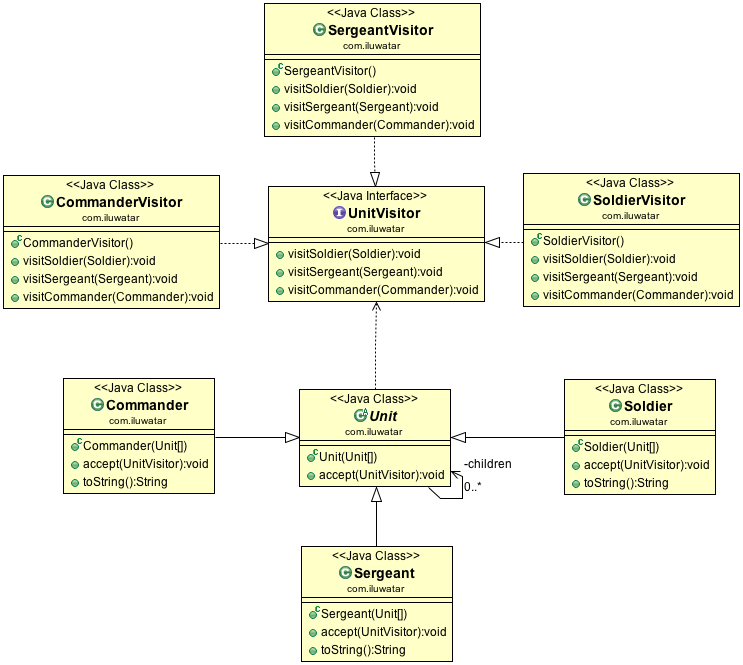Visitor
Intent
Represent an operation to be performed on the elements of an object structure. Visitor lets you
define a new operation without changing the classes of the elements on which it operates.
Explanation
Real-world example
Consider a tree structure with army units. Commander has two sergeants under it and each sergeant
has three soldiers under them. Given that the hierarchy implements the visitor pattern, we can
easily create new objects that interact with the commander, sergeants, soldiers, or all of them.
In plain words
Visitor pattern defines operations that can be performed on the nodes of the data structure.
Wikipedia says
In object-oriented programming and software engineering, the visitor design pattern is a way of
separating an algorithm from an object structure on which it operates. A practical result of this
separation is the ability to add new operations to existing object structures without modifying
the structures.
Programmatic Example
Given the army unit example from above, we first have the Unit and UnitVisitor base types.
public abstract class Unit {
private final Unit[] children;
public Unit(Unit... children) {
this.children = children;
}
public void accept(UnitVisitor visitor) {
Arrays.stream(children).forEach(child -> child.accept(visitor));
}
}
public interface UnitVisitor {
void visit(Soldier soldier);
void visit(Sergeant sergeant);
void visit(Commander commander);
}
Then we have the concrete units.
public class Commander extends Unit {
public Commander(Unit... children) {
super(children);
}
@Override
public void accept(UnitVisitor visitor) {
visitor.visit(this);
super.accept(visitor);
}
@Override
public String toString() {
return "commander";
}
}
public class Sergeant extends Unit {
public Sergeant(Unit... children) {
super(children);
}
@Override
public void accept(UnitVisitor visitor) {
visitor.visit(this);
super.accept(visitor);
}
@Override
public String toString() {
return "sergeant";
}
}
public class Soldier extends Unit {
public Soldier(Unit... children) {
super(children);
}
@Override
public void accept(UnitVisitor visitor) {
visitor.visit(this);
super.accept(visitor);
}
@Override
public String toString() {
return "soldier";
}
}
Here are then some concrete visitors.
@Slf4j
public class CommanderVisitor implements UnitVisitor {
@Override
public void visit(Soldier soldier) {
// Do nothing
}
@Override
public void visit(Sergeant sergeant) {
// Do nothing
}
@Override
public void visit(Commander commander) {
LOGGER.info("Good to see you {}", commander);
}
}
@Slf4j
public class SergeantVisitor implements UnitVisitor {
@Override
public void visit(Soldier soldier) {
// Do nothing
}
@Override
public void visit(Sergeant sergeant) {
LOGGER.info("Hello {}", sergeant);
}
@Override
public void visit(Commander commander) {
// Do nothing
}
}
@Slf4j
public class SoldierVisitor implements UnitVisitor {
@Override
public void visit(Soldier soldier) {
LOGGER.info("Greetings {}", soldier);
}
@Override
public void visit(Sergeant sergeant) {
// Do nothing
}
@Override
public void visit(Commander commander) {
// Do nothing
}
}
Finally, we can show the power of visitors in action.
commander.accept(new SoldierVisitor());
commander.accept(new SergeantVisitor());
commander.accept(new CommanderVisitor());
Program output:
Greetings soldier
Greetings soldier
Greetings soldier
Greetings soldier
Greetings soldier
Greetings soldier
Hello sergeant
Hello sergeant
Good to see you commander
Class diagram

Applicability
Use the Visitor pattern when
- An object structure contains many classes of objects with differing interfaces, and you want to perform operations on these objects that depend on their concrete classes.
- Many distinct and unrelated operations need to be performed on objects in an object structure, and you want to avoid "polluting" their classes with these operations. Visitor lets you keep related operations together by defining them in one class. When the object structure is shared by many applications, use Visitor to put operations in just those applications that need them.
- The classes defining the object structure rarely change, but you often want to define new operations over the structure. Changing the object structure classes requires redefining the interface to all visitors, which is potentially costly. If the object structure classes change often, then it's probably better to define the operations in those classes.
Tutorials
Known uses
- Apache Wicket component tree, see MarkupContainer
- javax.lang.model.element.AnnotationValue and AnnotationValueVisitor
- javax.lang.model.element.Element and Element Visitor
- java.nio.file.FileVisitor